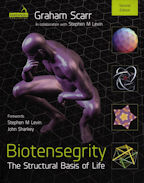Biotensegrity is a structural design principle that describes a relationship between every part of an organism and the mechanical system that integrates them into a complete functional unit. It is a conceptual model that causes a paradigm shift in biomechanical thinking and changing the way that we think about functional anatomy.
In Biotensegrity – The Structural Basis of Life, Graham Scarr explains the underlying concepts in an accessible way, covering the ground from first principles to their significance for functional anatomy and biomechanical theory. The book answers the question ‘What is biotensegrity?’; argues that all natural forms are the result of interactions between physical forces and the laws that govern them; and shows how a proper understanding of these basic principles leads to a better understanding of the human body as a functionally integrated and heterarchical unit. Along the way it touches on the newly emerging fields of soft matter, embryological development, complexity theory, and systems biology. The principles of biosensegrity form part of the basic science that underpins clnical reasoning andd are transforming traditional views of biomechanics.
This book will inspire she reader to take a deeper look at biological structure and find their own ways of applying it.
Who is the book for? Anatomists, biomechanics, physiologists and clinician – from hands-on therapists and movement teachers to surgeons, from students to seasoned professionals, and anyone who wants a better understanding of biological structure.
